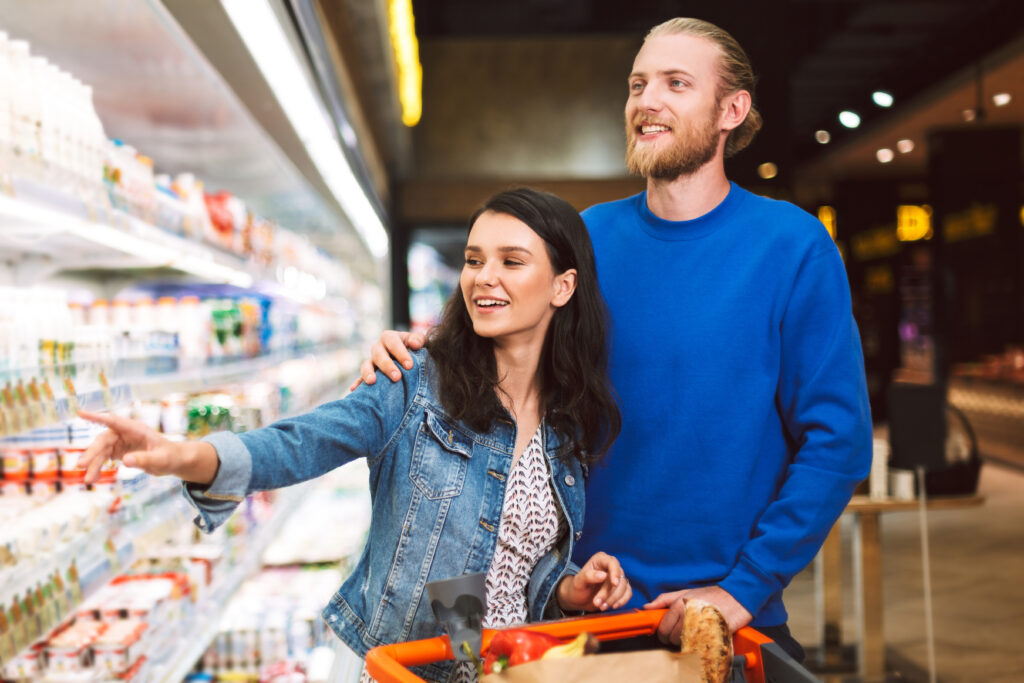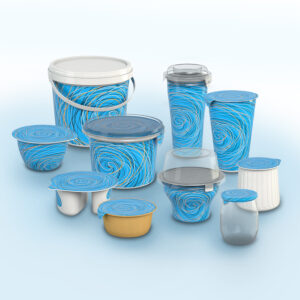Yogurt Cups: Why Material and Size Matters

Young joyful couple with trolley full of products happily choosing dairy products in modern supermarket
Strategic Packaging Choices Boost Branding and Sustainability
By Fabien Jégo, Design Leader of Packaging & Packaging Industrialization at Synerlink
Yogurt cups seem simple. Consumers may not know why one brand’s food cup is more appealing than another, why a cup looks and feels the way it does, or how it ends up conveniently face-out on a store shelf. Dairy brand managers, packagers, and shippers know that strategic packaging choices can help a company boost a product’s branding and support its sustainability. Yogurt cups offer an excellent demonstration of the benefits of new packaging design for marketing success, carbon reduction, recyclability, and CPG growth.
Thoughtful packaging design is critically important to product performance as it is often the brand’s first impression on consumers.
Package design is always a compromise. Packagers balance what designs show up best on a store shelf, customers’ preferences, the cost of production, sustainability of the packaging, and other premium cup features. As they do, they must assess whether to continue using packaging machinery that is not optimized for the current market or invest in new machinery that can keep up with current markets and even open new possibilities. How can packagers decide when to make a change?
Below are some of the factors to consider when deciding whether to adopt new packaging equipment or a new package design in 2022.
Food cup package design affects shelf visibility

New consumer package designs reflect people’s values, including freshness, naturalness and sustainability
Some container characteristics help a brand stand out in ways consumers may not consciously notice. A product’s “first impression” can be affected by:
Size: The height and width of your product’s face can be enlarged to maximize its visual impact.
Shape: A cone-shaped cup that is larger at the top may reflect dark store flooring. A can or ball shape will reflect bright store lighting, letting a product shine.
Quantity: When food cups are combined in a multipack, the repetition or continuity of the graphics can create greater visual impact.
Orientation: A multipack of a product will naturally be oriented correctly on a shelf, but individual yogurt cups must be manually oriented by someone in-store. If the front row of a product does not face forward, branding can be lost.
Shelf-ready packaging: When multipacks are bound into a single package, they can create a larger, more eye-catching unit amid smaller items.
Shadows: The traditional yogurt cup shape has an overhanging lip that casts unwanted shadows on a product. Modern packaging equipment can create a more discreet collar to minimize this effect.
New CPG package design can adapt to 2022’s consumers
New consumer package designs reflect people’s values, including freshness, naturalness and sustainability
Shoppers in 2022 have grown to value food products that reflect their values, including freshness, naturalness, and sustainability. They prefer matte-finished packaging, rather than the glossy finishes popular in the earlier 2000s. Transparency offers visual proof that the food product is fresh and wholesome. Paper and cardboard are appealing because they provide a natural feeling. Packaging for an organic or ethical product can reinforce the positive branding by listing sustainable and carbon-reduced features of packaging as well. Finally, consumers look to CPGs to provide new experiences, even when they eat at home. Updated packaging equipment can create custom containers that appeal to this desire for uniqueness.
Yogurt cup design can enhance sustainability
The primary challenge in today’s market is sustainability—both real and perceived. In its most recent State of the Industry Report, PMMI lists environmental factors as one of the major economic trends affecting the packaging industry. From a legal point of view, certain cup materials incur greater taxes or are banned outright in some countries.
Truly sustainable plastic should be recyclable for its original purpose, reducing the amount of plastic that ends up wasted in landfills and oceans. Polyethylene terephthalate (PET) plastic, for example, is allowed throughout the UK and EU and it can be recycled again for food use. PET can also be formed into containers using less material than other plastics and creating a lighter-weight cup. This reduces shipping weight, fuel consumption, and carbon footprint in shipping. Yogurt cups made from recyclable or part-recycled materials can reduce waste and close the recycling loop, helping our customers and consumers achieve their environmental goals.
Some challenges remain. Packagers have to consider what sustainable features customers will value. Some solutions, like a cardboard cup with a recyclable plastic liner, are too expensive for some markets. And community recycling programs remain an area of opportunity when companies assess the lifecycle impact of their packaging. However, new recycling channels are being established, due in part to industry support. In addition, thermoforming machine manufacturers are developing solutions to switch to more sustainable plastics and to reduce the production of non-recyclable containers.
As interested consumers learn more about sustainable packaging, trends suggest they will prefer containers that use fewer resources and that close the recycling loop. Until then, packaging creators can educate consumers about truly sustainable packaging by calling attention to their carbon reduction achievements.
Good CPG packaging can improve operational efficiency for customers
Yogurt cup package design can enhance production, shipping, and carbon reduction processes. Yogurt cup sizing, grouping, stackability, and weight all affect how easily and efficiently a product can be handled, shipped, and delivered. Newer machines can support packagers’ efforts to make the most of their resources.
Form-fill-seal (FFS) yogurt pots are the most efficient solution for packagers. They are less expensive to produce and use less material. They create a better carbon footprint, due to lightweighting for logistics and the elimination of the decontamination step required for other processes.
Fill-seal (FS) yogurt packaging offers flexibility with lower capital expenditures. FS machines accommodate a variety of pot sizes and materials, including plastic, cardboard, glass, and aluminum. They can handle many shapes (round, oval, square, conical) to help products stand out on shelves, and they are efficient for small and large runs.
Modern machines can take a brand farther
It can seem risky to transition away from a machine that could keep producing the same old product for years. However, a modern FS or FFS machine can better respond to market trends and marketing knowledge. Synerlink’s industry experts know how to work with today’s more adaptable packaging machinery to produce a better balance between improved materials, attractive design, shipping optimization, and consumer appeal. Consultants can meet with packagers to suggest marketing and technical solutions based on that company’s needs.
Takeaway: Yogurt cup material, size, and shape impact product performance
The age of identical cups on the shelf is over. Consumers want new experiences and sustainability in addition to freshness and convenience. Food cup package design has become a balance between consumer appeal, operational efficiency, and sustainability. Brands can adjust the shape, multipack size, labeling, material, and more to stand out in stores and homes.
Packagers that want to grow and succeed in the current market can reach out to a packaging machine supplier to find the most balanced packaging solution in terms of perceived value and industrialization for each product and the machine best suited to current and future markets.
About the Author
Fabien Jégo is the Design Leader of packaging and packaging industrialization at Synerlink. Fabien has an industrial design education, and 20 years of professional experience as a packaging designer and commercial engineer. For more information, visit www.synerlink.com.






